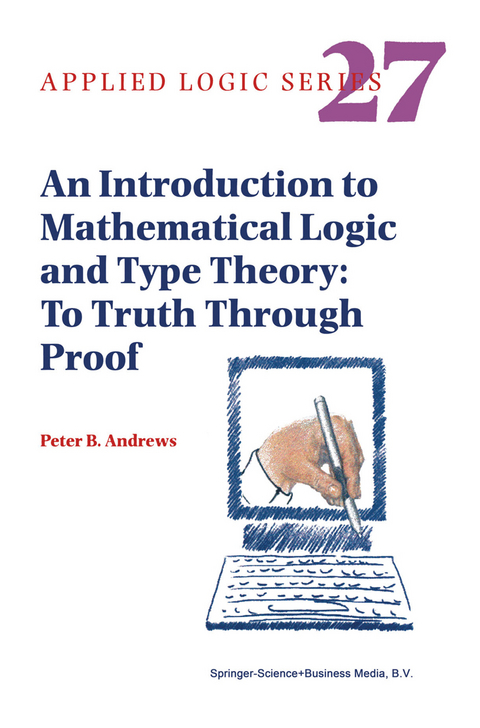
An Introduction to Mathematical Logic and Type Theory
To Truth Through Proof
Seiten
2010
|
2nd ed. 2002. Softcover reprint of the original 2nd ed. 2002
Springer (Verlag)
978-90-481-6079-2 (ISBN)
Springer (Verlag)
978-90-481-6079-2 (ISBN)
An introduction to mathematical logic that starts with propositional calculus and first-order logic. It covers topics such as: syntax, semantics, soundness, completeness, independence, normal forms, vertical paths through negation normal formulas, compactness, Smullyan's Unifying Principle, natural deduction, cut-elimination, and, Skolemization.
In case you are considering to adopt this book for courses with over 50 students, please contact ties.nijssen@springer.com for more information.
This introduction to mathematical logic starts with propositional calculus and first-order logic. Topics covered include syntax, semantics, soundness, completeness, independence, normal forms, vertical paths through negation normal formulas, compactness, Smullyan's Unifying Principle, natural deduction, cut-elimination, semantic tableaux, Skolemization, Herbrand's Theorem, unification, duality, interpolation, and definability.
The last three chapters of the book provide an introduction to type theory (higher-order logic). It is shown how various mathematical concepts can be formalized in this very expressive formal language. This expressive notation facilitates proofs of the classical incompleteness and undecidability theorems which are very elegant and easy to understand. The discussion of semantics makes clear the important distinction between standard and nonstandard models which is so important in understanding puzzling phenomena such as the incompleteness theorems and Skolem's Paradox about countable models of set theory.
Some of the numerous exercises require giving formal proofs. A computer program called ETPS which is available from the web facilitates doing and checking such exercises.
Audience: This volume will be of interest to mathematicians, computer scientists, and philosophers in universities, as well as to computer scientists in industry who wish to use higher-order logic for hardware and software specification and verification.
In case you are considering to adopt this book for courses with over 50 students, please contact ties.nijssen@springer.com for more information.
This introduction to mathematical logic starts with propositional calculus and first-order logic. Topics covered include syntax, semantics, soundness, completeness, independence, normal forms, vertical paths through negation normal formulas, compactness, Smullyan's Unifying Principle, natural deduction, cut-elimination, semantic tableaux, Skolemization, Herbrand's Theorem, unification, duality, interpolation, and definability.
The last three chapters of the book provide an introduction to type theory (higher-order logic). It is shown how various mathematical concepts can be formalized in this very expressive formal language. This expressive notation facilitates proofs of the classical incompleteness and undecidability theorems which are very elegant and easy to understand. The discussion of semantics makes clear the important distinction between standard and nonstandard models which is so important in understanding puzzling phenomena such as the incompleteness theorems and Skolem's Paradox about countable models of set theory.
Some of the numerous exercises require giving formal proofs. A computer program called ETPS which is available from the web facilitates doing and checking such exercises.
Audience: This volume will be of interest to mathematicians, computer scientists, and philosophers in universities, as well as to computer scientists in industry who wish to use higher-order logic for hardware and software specification and verification.
0 Introduction.- 1 Propositional Calculus.- 2 First-Order Logic.- 3 Provability and Refutability.- 4 Further Topics in First-Order Logic.- 5 Type Theory.- 6 Formalized Number Theory.- 7 Incompleteness and Undecidability.- Supplementary Exercises.- Summary of Theorems.- List of Figures.
| Erscheint lt. Verlag | 9.12.2010 |
|---|---|
| Reihe/Serie | Applied Logic Series ; 27 |
| Zusatzinfo | XVIII, 390 p. |
| Verlagsort | Dordrecht |
| Sprache | englisch |
| Maße | 155 x 235 mm |
| Themenwelt | Geisteswissenschaften ► Philosophie ► Logik |
| Geisteswissenschaften ► Sprach- / Literaturwissenschaft ► Sprachwissenschaft | |
| Mathematik / Informatik ► Informatik ► Software Entwicklung | |
| Informatik ► Theorie / Studium ► Künstliche Intelligenz / Robotik | |
| Mathematik / Informatik ► Mathematik ► Allgemeines / Lexika | |
| Mathematik / Informatik ► Mathematik ► Logik / Mengenlehre | |
| ISBN-10 | 90-481-6079-0 / 9048160790 |
| ISBN-13 | 978-90-481-6079-2 / 9789048160792 |
| Zustand | Neuware |
| Haben Sie eine Frage zum Produkt? |
Mehr entdecken
aus dem Bereich
aus dem Bereich
Buch | Softcover (2024)
REDLINE (Verlag)
CHF 27,95
Eine kurze Geschichte der Informationsnetzwerke von der Steinzeit bis …
Buch | Hardcover (2024)
Penguin (Verlag)
CHF 39,20


